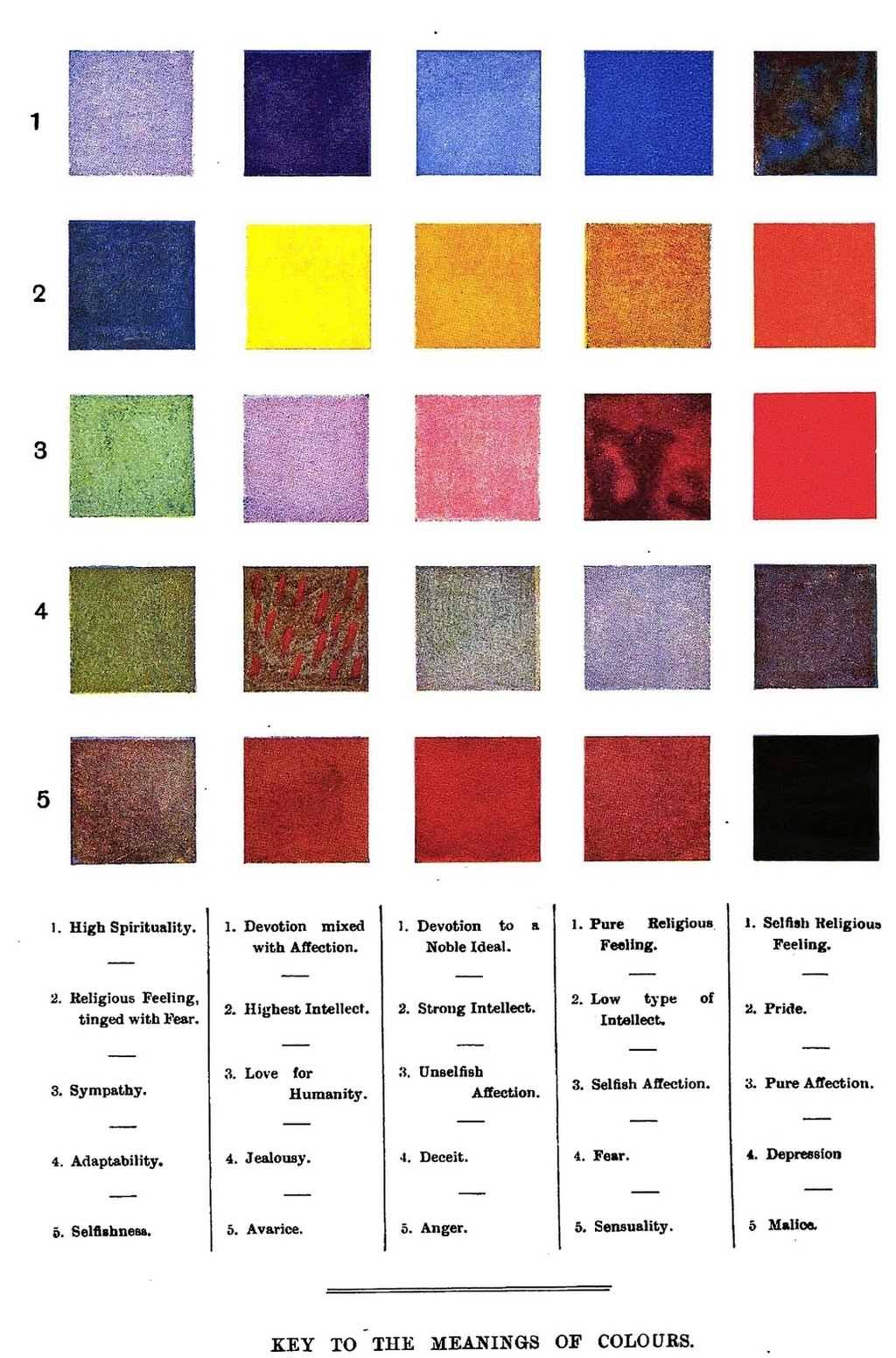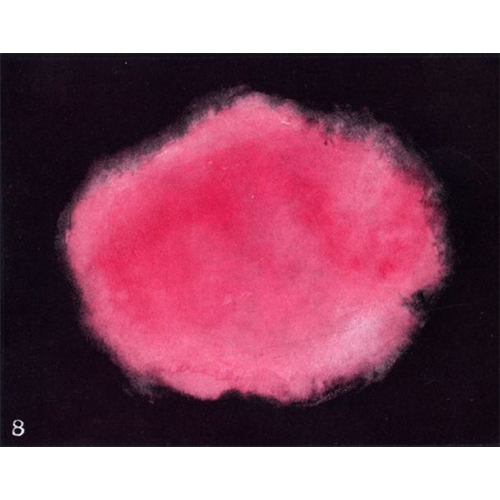Annie Besant & C.W. Leadbeater
Thought Forms

Thought Forms is a record of clairvoyant investigation, exploring the visualisation of our experiences, emotions and music. Originally published in 1905 by two leading members of the Theosophist Society, Annie Besant and C.W. Leadbeater, it attempts to translate the meaning behind the visual abstractions of our thoughts.
‘There is a hidden side to life, that each act and word and thought has its consequence in the unseen world which is always so near to us.’
When we feel or experience something Besant and Leadbeater argue that ‘thought-forms’ arise, manifesting as shapes, colours, auras and things seemingly beyond our imaginations, from places such as the astral plane. It conceives a theory of what it means for a thought to be an object with subsequent explanations of a range of different thought-forms.
Despite being derived from the occult the book had a huge underlying influence on the modern art of the 20th century, especially on artists such as Piet Mondrian, Kazimir Malevich, Hilma af Klint and Wassily Kandinsky. It encouraged the artist to go beyond the literalism of centuries past and push forth towards something that can seemingly be felt but not understood. Given that modernism as a concept didn’t exist at this time it serves as an interesting amalgamation of Eastern and Western philosophy forming a curiosity from looking at our emotions head on.
‘What else is a painting but a projection of thought-forms?’
The way we perceive colour and form is inherently emotional and I think continually exploring that is important. Though the descriptions can feel prescriptive at times the premise allows the reader to try and set themselves free from a stringent way of thinking.
At the beginning of the book there’s a chart which breaks down the association of colours and emotions which form the basis for the descriptions. There is a mysterious nature surrounding the translation of the forms themselves but there is a range described from ‘vague selfish affection’ to ‘upward rushes of devotion’ to an ‘intellectual conception of the cosmic order’.
‘There is a hidden side to life, that each act and word and thought has its consequence in the unseen world which is always so near to us.’
When we feel or experience something Besant and Leadbeater argue that ‘thought-forms’ arise, manifesting as shapes, colours, auras and things seemingly beyond our imaginations, from places such as the astral plane. It conceives a theory of what it means for a thought to be an object with subsequent explanations of a range of different thought-forms.
Despite being derived from the occult the book had a huge underlying influence on the modern art of the 20th century, especially on artists such as Piet Mondrian, Kazimir Malevich, Hilma af Klint and Wassily Kandinsky. It encouraged the artist to go beyond the literalism of centuries past and push forth towards something that can seemingly be felt but not understood. Given that modernism as a concept didn’t exist at this time it serves as an interesting amalgamation of Eastern and Western philosophy forming a curiosity from looking at our emotions head on.
‘What else is a painting but a projection of thought-forms?’
The way we perceive colour and form is inherently emotional and I think continually exploring that is important. Though the descriptions can feel prescriptive at times the premise allows the reader to try and set themselves free from a stringent way of thinking.
At the beginning of the book there’s a chart which breaks down the association of colours and emotions which form the basis for the descriptions. There is a mysterious nature surrounding the translation of the forms themselves but there is a range described from ‘vague selfish affection’ to ‘upward rushes of devotion’ to an ‘intellectual conception of the cosmic order’.

There are three general principles set out in the book:
- Quality of thought determines colour
- Nature of thought determines form
- Definiteness of thought determines clearness
Naturally, there is a difficulty in translating thought-forms given that it is essentially an investigation of something that seems ethereal. The subtle forces by which the soul expresses itself flows through various types of temperaments. Every thought gives rise to a set of correlated vibrations in the matter of the body accompanied with colour, like that in the spray of a waterfall as the sunlight strikes it, always having such a vivid delicacy. The forms take either the image of the thinker, the image of some material object or a structure entirely of its own, expressing its inherent qualities in the matter which draws round it.
‘The devotional thought of an unselfish heart is very lovely in colour, like the deep blue of a summer sky.’
Below are a few of my favourite thought-forms and corresponding explanations presented in the book.
Vague Pure Affection

This is a revolving cloud of pure affection. The person from whom it emanates is happy and at peace with the world, thinking dreamily of some friend whose very presence is a pleasure. It is one of gentle well-being, and of an unselfish delight in the proximity of those who are beloved. Gradually enlarging concentric shells of rosy cloud, fading into invisibility at a distance of a few feet from their drowsily contented creator.
![Fig. 19]()
The upper form is not uncommon, and indicates the determination to solve some problem, the intention to know and understand. A form of this kind frequently accompanies a question, and if, as is sometimes unfortunately the case, the question is put less with the genuine desire for knowledge than for the purpose of exhibiting the acumen of the questioner, the form is strongly tinged with the deep orange that indicates conceit.
![Fig. 35]()
This form represents the feeling of a man upon meeting a friend from whom he has been long separated. The convex surface of the crescent is nearest to the thinker, and its two arms stretch out towards the approaching friend as if to embrace him. The rose colour naturally betokens the affection felt, the light green shows the depth of the sympathy which exists, and the clear yellow is a sign of the intellectual pleasure with which the creator of the thought anticipates the revival of delightful reminiscences of days long gone by.
The Intention to Know

On Meeting a Friend

An Aspiration to Enfold all

This form was generated by one who was trying, while sitting in meditation, to fill his mind with an aspiration to enfold all mankind in order to draw them upward towards the high ideal which shone so clearly before his eyes. The form seems to rush out from him, to curve round upon itself, and return to its base.
The last few thought-forms in the book focus on those built by music which really resonated with me and especially the way I listen to music. My favourite is the one which is supposedly manifested from someone listening to a chorus by Charles Gounod.
